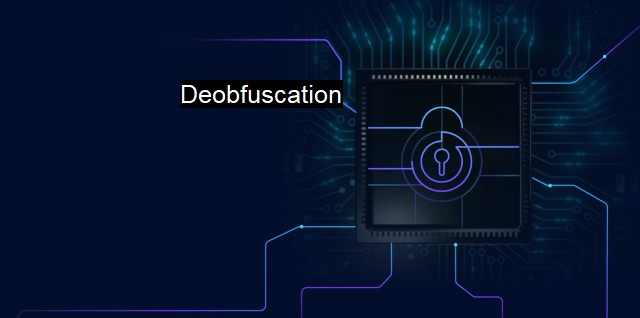What is Deobfuscation?
Deobfuscation: Essential Weapon in Cybersecurity Testing Against Malware and Hackers
Deobfuscation is a vital process in cybersecurity and the functioning of antivirus software. It refers to the process of reversing the obscuring of source code, making a program clearer and easier to comprehend. To understand deobfuscation, it's critical first to grasp what obfuscation means - why and how it is deployed.Obfuscation, in the context of software programming, involves making the source code of a program extremely difficult to understand and interpret. A developer might obfuscate their code to protect intellectual property, hide sensitive data, or deter malicious agents from understanding how a program functions.
Cybercriminals also deploy obfuscation. They obscure malicious code to evade detection and infiltration by security protocols and antivirus software. it's a technique that disguises one's intentions from those on the defense side of cybersecurity.
In light of the abuse of obfuscation by cybercriminals, the deobfuscation process has become an integral part of cybersecurity. Deobfuscation tools and techniques are critical in reversing the obfuscation, rendering the malicious code comprehensible. This enables cybersecurity professionals to understand the workings of a hostile program or a piece of malware, identify its source, and design defensible counteractions.
Deobfuscation can be carried out manually or automatically. Manual deobfuscation involves a thorough, step-by-step analysis of the code, decrypting algorithm patterns, converting code from one form to another, and simplifying the code in a process known as code refactoring. Depending on the level of obfuscation, this process requires high-level proficiency in coding and can be time-consuming and labor intensive.
On the other hand, automatic deobfuscation utilizes tools and software developed specifically for this task. These applications use a range of methodologies to parse through the convoluted code, string manipulation, and data flow analysis to revert the code back to a readable format. An example of an automatic deobfuscation tool in action is a modern antivirus software that has a built-in deobfuscator to unmask the illegible, malicious scripts.
It's not just antivirus software that uses deobfuscation; firewalls, intrusion detection systems (IDS), and malware analysis tools also employ this technique to aid in identifying potential threats.
In practice let's say a cyber attacker obscures a virus' code to prevent antivirus software from flagging it. The antivirus software, using built-in deobfuscation tactics, reverts the code into a legible format. By doing so, the antivirus software can identify what data the virus might be targeting, how it's likely to mobilize that data, and stop it in its tracks.
As hackers continue advancing their obfuscation techniques, deobfuscation tools and strategies must also grow in sophistication. a response to polymorphic malware, which changes its visible features such as file names and types to avoid detection, is a type of deobfuscation known as normalization where the hidden constants inside the code are unveiled.
Therefore, deobfuscation plays a pivotal role in ensuring network security and enhancing antivirus capabilities. With increased digital connectivity, it becomes pressing to understand the techniques employed by infiltrators to bypass cybersecurity measures. With an understanding of these techniques, professionals can capitalize on deobfuscation methods to protect against these breaches effectively.
Obfuscation and deobfuscation are parallel strategies used by the attackers and defenders in the cybersecurity landscape. Particularly integral to the functioning of antivirus software, the use of deobfuscation increases the probability of uncovering cyber threats, ensuring stronger, robust, and proactive defense mechanisms against sizeable digital threats. It flips the script on malicious actors, turning their primary clandestine weapon into an instrument for their downfall.

Deobfuscation FAQs
What is deobfuscation?
Deobfuscation is a process that involves deciphering obfuscated code or data to make it readable and understandable. It is often used in cybersecurity to detect and analyze malware that is designed to be difficult to understand.Why is deobfuscation important in antivirus software?
Deobfuscation is important in antivirus software because many malware programs are designed to be difficult to detect through obfuscation techniques. By deobfuscating malware code or data, antivirus software can better identify and analyze potential threats.What are some common techniques used in deobfuscation?
Some common deobfuscation techniques include reverse engineering, dynamic analysis, and static analysis. Reverse engineering involves breaking down a piece of code to determine its purpose, while dynamic analysis involves running software in a controlled environment to observe its behavior. Static analysis involves examining a program without executing it.What are the potential risks in deobfuscating malicious code?
There are potential risks in deobfuscating malicious code, as it may activate harmful actions or trigger a security breach if not handled properly. It is important to use caution when attempting to deobfuscate malware and ensure that proper security protocols are in place to prevent any unintentional damage.Related Topics
Malware analysis Code obfuscation Reverse engineering Static analysis Dynamic analysis
| | A | | | B | | | C | | | D | | | E | | | F | | | G | | | H | | | I | | | J | | | K | | | L | | | M | |
| | N | | | O | | | P | | | Q | | | R | | | S | | | T | | | U | | | V | | | W | | | X | | | Y | | | Z | |
| | 1 | | | 2 | | | 3 | | | 4 | | | 7 | | | 8 | | |||||||